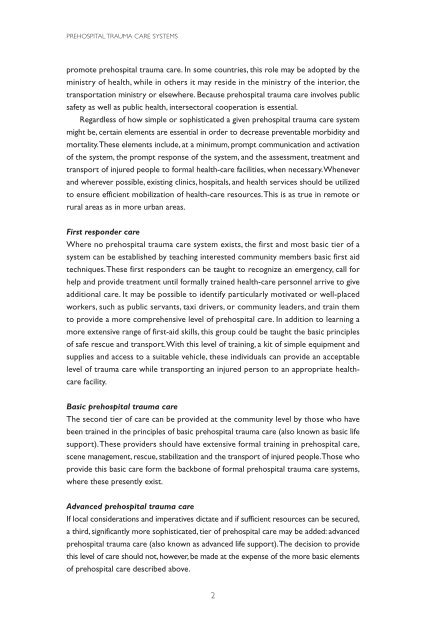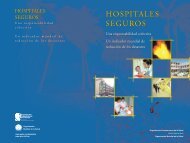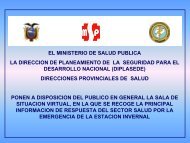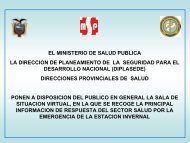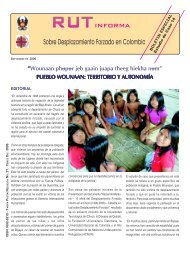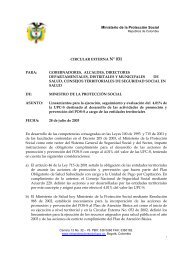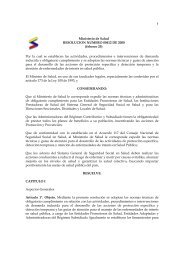Prehospital trauma care systems - World Health Organization
Prehospital trauma care systems - World Health Organization
Prehospital trauma care systems - World Health Organization
Create successful ePaper yourself
Turn your PDF publications into a flip-book with our unique Google optimized e-Paper software.
PREHOSPITAL TRAUMA CARE SYSTEMS<br />
promote prehospital <strong>trauma</strong> <strong>care</strong>. In some countries, this role may be adopted by the<br />
ministry of health, while in others it may reside in the ministry of the interior, the<br />
transportation ministry or elsewhere. Because prehospital <strong>trauma</strong> <strong>care</strong> involves public<br />
safety as well as public health, intersectoral cooperation is essential.<br />
Regardless of how simple or sophisticated a given prehospital <strong>trauma</strong> <strong>care</strong> system<br />
might be, certain elements are essential in order to decrease preventable morbidity and<br />
mortality.These elements include, at a minimum, prompt communication and activation<br />
of the system, the prompt response of the system, and the assessment, treatment and<br />
transport of injured people to formal health-<strong>care</strong> facilities, when necessary.Whenever<br />
and wherever possible, existing clinics, hospitals, and health services should be utilized<br />
to ensure efficient mobilization of health-<strong>care</strong> resources.This is as true in remote or<br />
rural areas as in more urban areas.<br />
First responder <strong>care</strong><br />
Where no prehospital <strong>trauma</strong> <strong>care</strong> system exists, the first and most basic tier of a<br />
system can be established by teaching interested community members basic first aid<br />
techniques.These first responders can be taught to recognize an emergency, call for<br />
help and provide treatment until formally trained health-<strong>care</strong> personnel arrive to give<br />
additional <strong>care</strong>. It may be possible to identify particularly motivated or well-placed<br />
workers, such as public servants, taxi drivers, or community leaders, and train them<br />
to provide a more comprehensive level of prehospital <strong>care</strong>. In addition to learning a<br />
more extensive range of first-aid skills, this group could be taught the basic principles<br />
of safe rescue and transport.With this level of training, a kit of simple equipment and<br />
supplies and access to a suitable vehicle, these individuals can provide an acceptable<br />
level of <strong>trauma</strong> <strong>care</strong> while transporting an injured person to an appropriate health<strong>care</strong><br />
facility.<br />
Basic prehospital <strong>trauma</strong> <strong>care</strong><br />
The second tier of <strong>care</strong> can be provided at the community level by those who have<br />
been trained in the principles of basic prehospital <strong>trauma</strong> <strong>care</strong> (also known as basic life<br />
support).These providers should have extensive formal training in prehospital <strong>care</strong>,<br />
scene management, rescue, stabilization and the transport of injured people.Those who<br />
provide this basic <strong>care</strong> form the backbone of formal prehospital <strong>trauma</strong> <strong>care</strong> <strong>systems</strong>,<br />
where these presently exist.<br />
Advanced prehospital <strong>trauma</strong> <strong>care</strong><br />
If local considerations and imperatives dictate and if sufficient resources can be secured,<br />
a third, significantly more sophisticated, tier of prehospital <strong>care</strong> may be added: advanced<br />
prehospital <strong>trauma</strong> <strong>care</strong> (also known as advanced life support).The decision to provide<br />
this level of <strong>care</strong> should not, however, be made at the expense of the more basic elements<br />
of prehospital <strong>care</strong> described above.<br />
2


